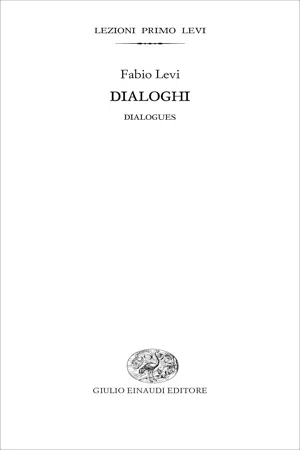
- 160 pagine
- Italian
- ePUB (disponibile sull'app)
- Disponibile su iOS e Android
Informazioni su questo libro
«Io sono uno che ha bisogno di comunicare molto, se non riesco a comunicare soffro, ho bisogno di parlare o scrivere, avere se possibile una comunicazione ad andata e ritorno». In questa frase, cosí semplice e diretta, si avverte una molteplice urgenza: di esprimersi e di ascoltare trovando interlocutori ovunque, di ogni età, condizione sociale e livello culturale. Primo Levi ha raccontato - di Auschwitz e di molto altro - agli studenti italiani nati nel dopoguerra e ai tedeschi dell'èra post-nazista, ma anche al se stesso di quarant'anni dopo il Lager, in dialoghi che ha saputo costruire con pazienza, schiettezza e intelligenza. Nell'illustrarne trame e intonazioni questa Lezione si rivolge a un sempre rinnovato interlocutore di Levi: il lettore di oggi e di domani.***"I am a person who needs to communicate constantly, who suffers if he cannot communicate. I need to speak and to write, to have a two-way communication, if possible." This sentence, so simple and direct, reveals a multitude of compelling needs: to express himself and to listen, finding interlocutors everywhere, of every age, social condition, and level of culture. Primo Levi spoke - about Auschwitz and much more - to Italian students who were born after WWII, to Germans from the post-Nazi era, and also to the person he had become forty years after the Lager, in dialogues he constructed with patience, straightforwardness, and intelligence. As it illustrates the various weaves and inflections, this Lezione addresses Levi's ever-renewing pool of interlocutors: the readers of today and tomorrow.
Domande frequenti
- Base è ideale per studenti e professionisti che amano esplorare un’ampia varietà di argomenti. Accedi alla Biblioteca Base con oltre 800.000 titoli affidabili e best-seller in business, crescita personale e discipline umanistiche. Include tempo di lettura illimitato e voce Read Aloud standard.
- Completo: Perfetto per studenti avanzati e ricercatori che necessitano di accesso completo e senza restrizioni. Sblocca oltre 1,4 milioni di libri in centinaia di argomenti, inclusi titoli accademici e specializzati. Il piano Completo include anche funzionalità avanzate come Premium Read Aloud e Research Assistant.
Nota che non possiamo supportare dispositivi con iOS 13 o Android 7 o versioni precedenti. Scopri di più sull’utilizzo dell’app.
Informazioni
Dialogues
The first interlocutors
(...) Throughout the journey in Russia, this impact, this shock, remained in the background a bit. As soon as I returned home, I was very sick for months.2
(...) I felt a physical need, an urgent need to recount these things (...). People considered me almost unbalanced because I talked and talked, at the cafeteria, in the evening, and also during the day; some people thought I even talked inappropriately.3
(...) Other people and I voraciously stored everything, all the experiences; in fact, we searched them out: we’d interrogate one other to learn each other’s stories.6
(...) they had declared us ‘other,’ and other we would remain; we took sides, but we kept ourselves apart from the stupid, cruel games of the Aryans.7
(...) it struck me as the only decent thing a young person my age, in my condition, could do.9
(...) short, tragic, and also stupid experience because now, with hindsight (…), now I know that it’s not the way it’s done, but you have to remember that I called myself a partisan fighter very early on, in November ‘43, when the Resistance didn’t exist yet.10
(...) First of all, it was important to me that I bear witness; I knew I was one of the very few Italians who had survived the extermination camps and it was important to me that I testify as though I were in court.14
(...) had written it (…) for the Germans (…). Because they were the parties in question (…). I felt like a witness. The judges are my readers, but who is the defendant? Nazi Germany, not the Germans, naturally, certain Germans, a good many of them.18
(...) even dangerously successful, they almost suffocated me. They had invited me to comment on the photographs on display and to talk [about If This Is a Man].I found myself inundated with questions by young people, even younger than me...Still now, I remember with some fright that it was my first public appearance; I found myself truly besieged and bombarded with questions.21
(...) But the exhibition is addressed not to fathers but to children, and to the children of children, with the aim of demonstrating what reserves of ferocity lie in the depths of the human spirit, and what dangers, today as yesterday, threaten our civilization.23
Indice dei contenuti
- Copertina
- Frontespizio
- Abbreviazioni
- Introduzione
- Dialoghi
- Appendice
- English editions of reference
- Introduction
- Dialogues
- Appendix
- Il libro
- L’autore
- Copyright